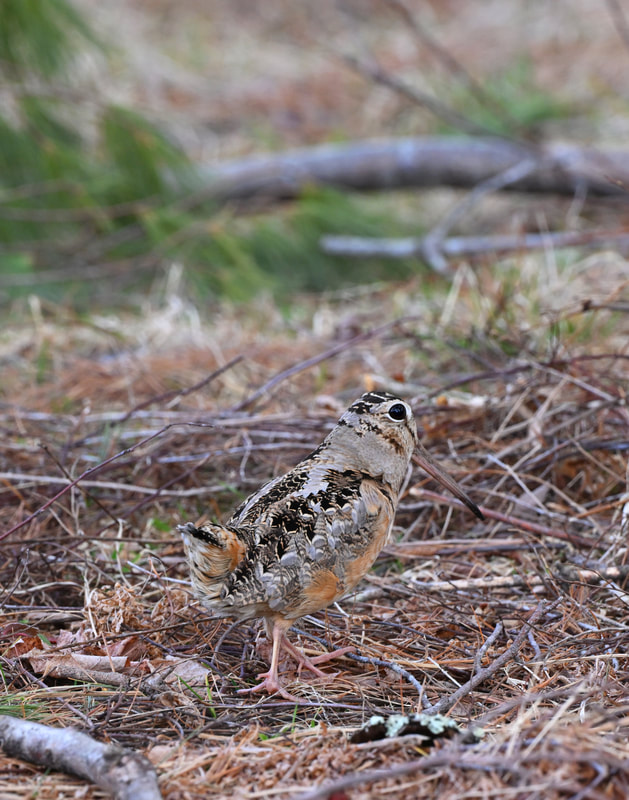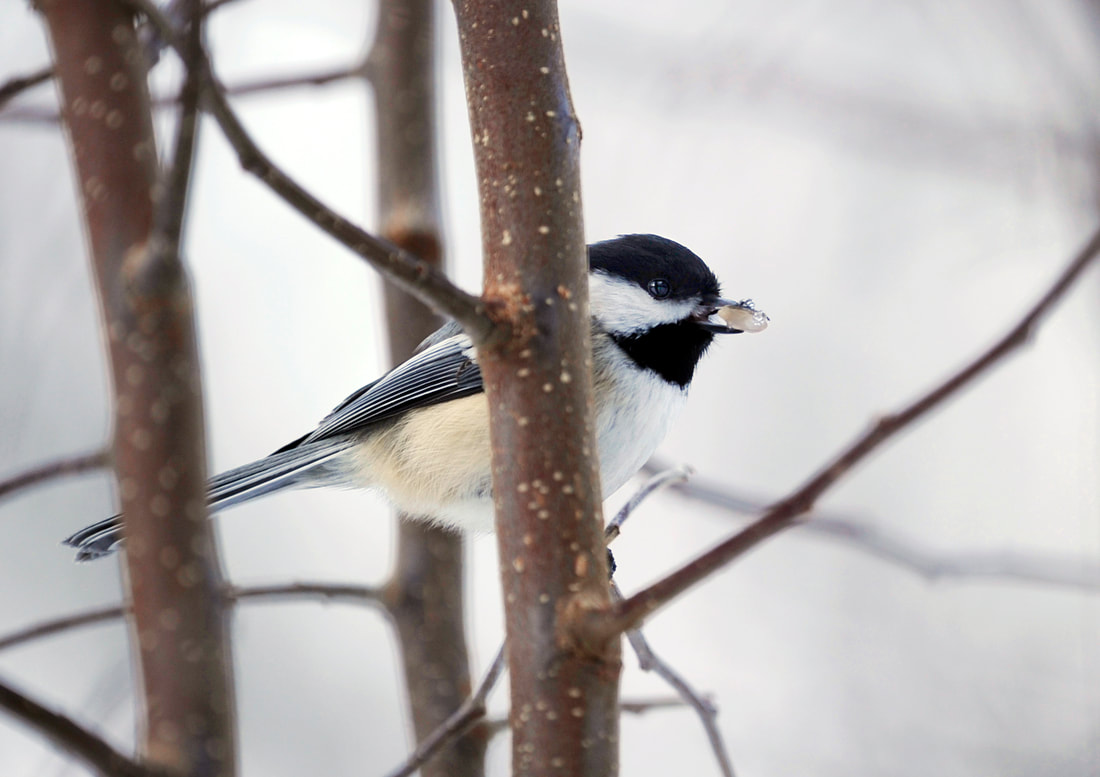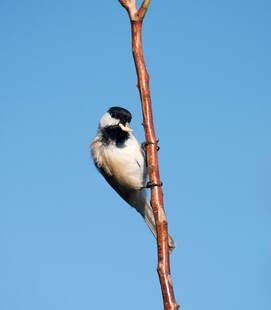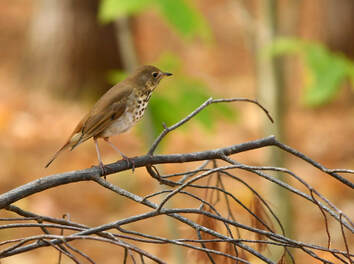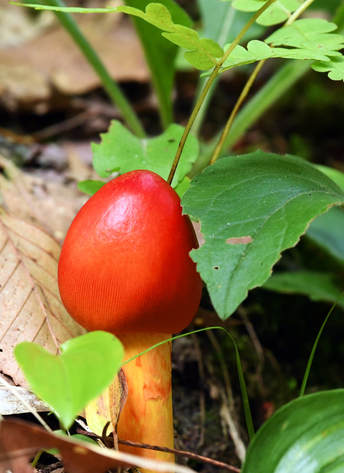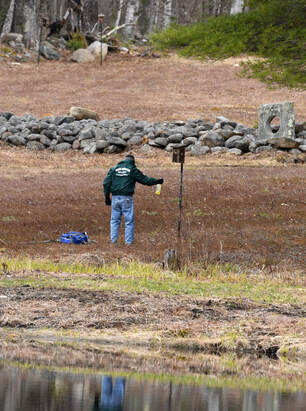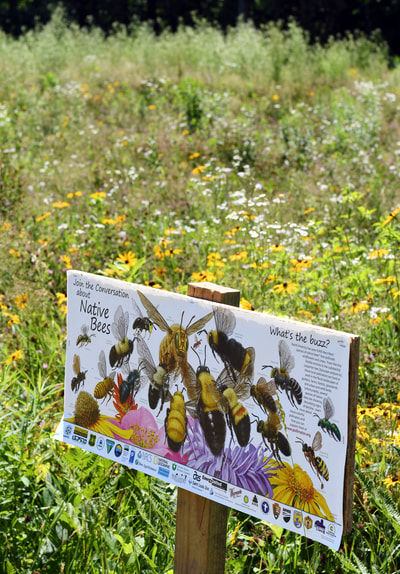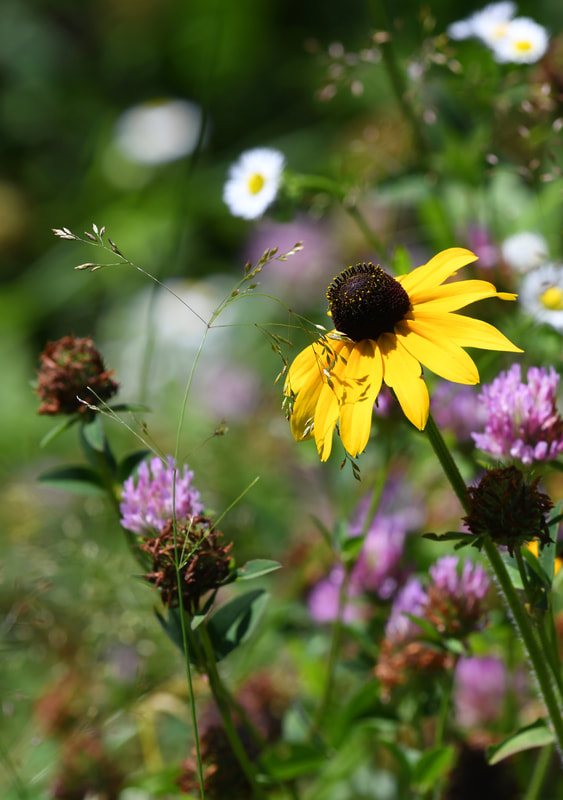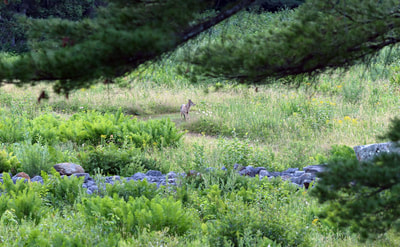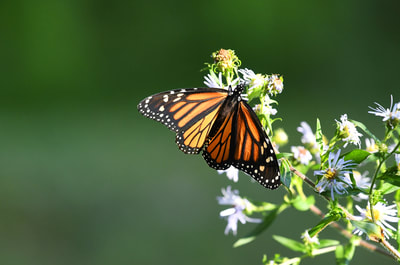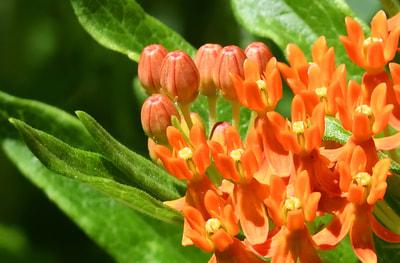WILDLIFE HABITAT MANAGEMENT
NO HUNTING • NO FISHING • NO TRAPPING
|
MILKWEED FOR POLLINATORS
Milkweed Asclepias incarnata Here at Chapman Sanctuary and Visny Woods we are pleased to have a nice patch of Milkweed growing among the many other wonderful wildflowers in the meadow. We have not seen any Monarch butterflies yet, but this small area of Milkweed is already attracting lots of pollinators who make their home at the sanctuary. |
CSVW IS HERE FOR THE WILDLIFE AND YOU
Part of caring for larger wildlife species and the environment includes caring for the
smallest of earth’s creatures.
CSVW maintains a large variety of flowers, grasses, trees and other vegetation that grow, bloom or fruit virtually year-round. The flowers in the Chapman House gardens, in the meadow, around Teacup Lake and in the Perennial Garden attract hundreds if not thousands of species from the tiniest bees & insects to the larger pollinators such as birds and bats.
Chapman Sanctuary and Visny Woods is proud to create and improve a variety of wildlife habitats for our feathered, furry and winged friends to live … and for YOU to explore and enjoy. Sanctuary trails are open FREE of charge for our members, neighbors and the public every day of the year from dawn until dusk.
WE HOPE YOU WILL JOIN US OUTSIDE IN NATURE AT CSVW
Visit the sanctuary soon and often to enjoy all the beauty that a protected, natural woodland has to offer.
The trails, gardens, meadow & Teacup Lake are lush and lively and simply beautiful.
Part of caring for larger wildlife species and the environment includes caring for the
smallest of earth’s creatures.
CSVW maintains a large variety of flowers, grasses, trees and other vegetation that grow, bloom or fruit virtually year-round. The flowers in the Chapman House gardens, in the meadow, around Teacup Lake and in the Perennial Garden attract hundreds if not thousands of species from the tiniest bees & insects to the larger pollinators such as birds and bats.
Chapman Sanctuary and Visny Woods is proud to create and improve a variety of wildlife habitats for our feathered, furry and winged friends to live … and for YOU to explore and enjoy. Sanctuary trails are open FREE of charge for our members, neighbors and the public every day of the year from dawn until dusk.
WE HOPE YOU WILL JOIN US OUTSIDE IN NATURE AT CSVW
Visit the sanctuary soon and often to enjoy all the beauty that a protected, natural woodland has to offer.
The trails, gardens, meadow & Teacup Lake are lush and lively and simply beautiful.
|
AMERICAN WOODCOCK
Scolopax minor ORDER: Charadriiformes FAMILY: Scolopacidae A shorebird in the forest? YES! This stalky little ground-dweller is actually in the Sandpiper family and was recently spotted here at Chapman Sanctuary and Visny Woods. Unlike other “shorebirds” the American Woodcock (aka the Timberdoodle) prefers a mix of forests, fields, wet meadows and brushy areas with moist soil. Extremely successful camouflage makes the American Woodcock very difficult to find hidden in leaf litter or in a shrubby thicket. Their plumage is a mottled brown, grey and rusty color; and even their legs and beaks resemble the twigs and branches of their environment. |
The American Woodcock’s diet consists of earthworms and other invertebrates they find in the soil such as insects, beetles and snails. Their earthworm-heavy diet makes them vulnerable to ground-poisoning; so preserving an environment suitable for breeding is necessary to prevent a decline in their population.
Chapman Sanctuary and Visny Woods is proud to offer a protected, natural habitat with food and nesting resources for this quirky little bird.
While the Woodcock’s remarkable camouflage makes it hard for predators to spot them; their conspicuous mating display is hard for females of the species to miss! Generally after a springtime sunset, males will begin their mating dance with a loud nasal sounding “peent!” call while turning in circles. Suddenly the male will take off and soar high into the sky twisting and spiraling while chirping and twittering. At the flight’s highest point of up to 200-300 feet, the male Woodcock will make a tumbling dive back to the ground and start the “sky dance” over again.
During spring breeding, the female usually makes a shallow “nest” in the leaves and twigs on the ground and incubates 1-4 eggs for approximately 20 days. Females tend to the young who leave the nest just a few hours after hatching. Mother will feed and tend to her offspring until they are independent at roughly 5 weeks old. The male gives no parental care, and continues to display long after most females have laid eggs. Woodcocks are solitary birds outside of nesting season.
The American Woodcock is a fascinating species of bird that we are thrilled to have making their home here on the CSVW acreage.
Chapman Sanctuary and Visny Woods is proud to offer a protected, natural habitat with food and nesting resources for this quirky little bird.
While the Woodcock’s remarkable camouflage makes it hard for predators to spot them; their conspicuous mating display is hard for females of the species to miss! Generally after a springtime sunset, males will begin their mating dance with a loud nasal sounding “peent!” call while turning in circles. Suddenly the male will take off and soar high into the sky twisting and spiraling while chirping and twittering. At the flight’s highest point of up to 200-300 feet, the male Woodcock will make a tumbling dive back to the ground and start the “sky dance” over again.
During spring breeding, the female usually makes a shallow “nest” in the leaves and twigs on the ground and incubates 1-4 eggs for approximately 20 days. Females tend to the young who leave the nest just a few hours after hatching. Mother will feed and tend to her offspring until they are independent at roughly 5 weeks old. The male gives no parental care, and continues to display long after most females have laid eggs. Woodcocks are solitary birds outside of nesting season.
The American Woodcock is a fascinating species of bird that we are thrilled to have making their home here on the CSVW acreage.
HAVE YOU SEEN ANY OF THESE ORDINARY BIRDS IN YOUR AREA?
|
No - you have not.
That’s because the birds that spend their winters in New England are extraordinary! As we know, winter temperatures can fall well below freezing in the Sandwich, NH region. Large amounts of snow can bury food sources and natural habitats. Wind can funnel hard over the mountains and blow down branches where birds could ride out a storm or roost at night. |
|
Winter can be a difficult existence for tiny birds who weigh just a few ounces at most.
The adaptations and survival skills required to survive a winter in New England are anything but ordinary. The species that do stay in the area have adapted different characteristics, skills and strategies
to survive the coldest months.
Black-capped Chickadees are one of the bird species who stay in New England year-round and find food and shelter to endure the winter in the forests and fields.
In the spring and summer months, Black-capped Chickadees eat lots of insects, larvae and caterpillars et al. They make a switch in the winter so that the bulk of their diet comes from seeds, berries and vegetable matter. Chickadees will also eat animal fats either in the form of suet cakes provided by humans, or from a found animal carcass.
Black-capped Chickadees spend countless hours finding hiding places for individual food items. These birds can remember hundreds or even thousands of food-storage locations and return to them when needed. Since a huge quantity of food is needed for Chickadees to pack on the calories required to fuel their tiny bodies and keep warm in winter, this is a super way to help ensure a source of nutrition.
The adaptations and survival skills required to survive a winter in New England are anything but ordinary. The species that do stay in the area have adapted different characteristics, skills and strategies
to survive the coldest months.
Black-capped Chickadees are one of the bird species who stay in New England year-round and find food and shelter to endure the winter in the forests and fields.
In the spring and summer months, Black-capped Chickadees eat lots of insects, larvae and caterpillars et al. They make a switch in the winter so that the bulk of their diet comes from seeds, berries and vegetable matter. Chickadees will also eat animal fats either in the form of suet cakes provided by humans, or from a found animal carcass.
Black-capped Chickadees spend countless hours finding hiding places for individual food items. These birds can remember hundreds or even thousands of food-storage locations and return to them when needed. Since a huge quantity of food is needed for Chickadees to pack on the calories required to fuel their tiny bodies and keep warm in winter, this is a super way to help ensure a source of nutrition.
Chickadees retain their body heat in some fascinating ways.
We probably have all seen birds with their feathers all fluffed up on a cold day. This behavior does more than just make them look like cute little puff-balls. Bird feathers are among the best natural insulators. The feather fluffing technique traps air next to the body and acts as insulation for the body. Chickadees and other birds also will often use shivering as a way to keep warm.
It is important that Black-capped Chickadees find shelter at night in a tree hole or other crevice. Once inside, these birds may shiver throughout the night to keep their body temperature where it needs to be. This warming method uses up important fat reserves, so the food-finding cycle will need to begin again early in the daylight.
It has also been learned that Black-capped Chickadees are able to go into a kind of hypothermia, lowering their body temperature to slow metabolism and conserve energy in extreme cold.
Black-capped Chickadees remain in flocks throughout the winter. When one bird locates a good source of food, all members of the flock benefit. Other birds take notice too and often there are large numbers of birds on a berry bush or at feeders all at once. Generally there is safety in numbers and when one bird sounds an alarm for possible danger, the entire flock reacts. More birds surviving the winter allows for more breeding opportunity in the spring.
Black-capped Chickadees are resourceful survivors.
Studies have found that the Black-capped Chickadee’s winter survival rate is improved when supplemental food is provided. Providing seed and suet at bird feeders is a great benefit to them and so many other birds when weather and temperatures become extreme.
Here at Chapman Sanctuary and Visny Woods, we provide some “extras” to help out local year-round bird populations and contribute to their survival. Those species include:
Our natural forests and hand-made birdhouses are a wonderful habitat for birds to find food and shelter throughout the winter.
Which “ordinary” birds have you been watching in your neck of the woods? What are some of the behaviors you have observed that help birds survive the winter? Send us an email ([email protected]) or a quick note on social media and let us know … we would love to hear about it!
Have any photos of the birds you are watching this winter?
We would love to see them!
Many bird species make Chapman Sanctuary and Visny Woods their year-round home. We are proud to be able to support local birds and wildlife in whatever way we can with help from our CSVW Members, Volunteers, Contributors and Birdhouse Sponsors. WE THANK YOU!
We probably have all seen birds with their feathers all fluffed up on a cold day. This behavior does more than just make them look like cute little puff-balls. Bird feathers are among the best natural insulators. The feather fluffing technique traps air next to the body and acts as insulation for the body. Chickadees and other birds also will often use shivering as a way to keep warm.
It is important that Black-capped Chickadees find shelter at night in a tree hole or other crevice. Once inside, these birds may shiver throughout the night to keep their body temperature where it needs to be. This warming method uses up important fat reserves, so the food-finding cycle will need to begin again early in the daylight.
It has also been learned that Black-capped Chickadees are able to go into a kind of hypothermia, lowering their body temperature to slow metabolism and conserve energy in extreme cold.
Black-capped Chickadees remain in flocks throughout the winter. When one bird locates a good source of food, all members of the flock benefit. Other birds take notice too and often there are large numbers of birds on a berry bush or at feeders all at once. Generally there is safety in numbers and when one bird sounds an alarm for possible danger, the entire flock reacts. More birds surviving the winter allows for more breeding opportunity in the spring.
Black-capped Chickadees are resourceful survivors.
Studies have found that the Black-capped Chickadee’s winter survival rate is improved when supplemental food is provided. Providing seed and suet at bird feeders is a great benefit to them and so many other birds when weather and temperatures become extreme.
Here at Chapman Sanctuary and Visny Woods, we provide some “extras” to help out local year-round bird populations and contribute to their survival. Those species include:
- Black-capped Chickadees
- Woodpeckers
- Blue Jays
- Cardinals
- Tufted Titmouse
- Finches
- Juncos
- MANY more
Our natural forests and hand-made birdhouses are a wonderful habitat for birds to find food and shelter throughout the winter.
Which “ordinary” birds have you been watching in your neck of the woods? What are some of the behaviors you have observed that help birds survive the winter? Send us an email ([email protected]) or a quick note on social media and let us know … we would love to hear about it!
Have any photos of the birds you are watching this winter?
We would love to see them!
Many bird species make Chapman Sanctuary and Visny Woods their year-round home. We are proud to be able to support local birds and wildlife in whatever way we can with help from our CSVW Members, Volunteers, Contributors and Birdhouse Sponsors. WE THANK YOU!
2023
WILDLIFE SIGHTINGS & HABITAT
WILDLIFE SIGHTINGS & HABITAT
2022
BRUSH PILES & DOWNED TREES
CSVW puts the needs of wildlife above all else in its care and management of the forest and trails.
CSVW puts the needs of wildlife above all else in its care and management of the forest and trails.
|
Have you been on the trails and wondered why brush piles have been left here and there along the way? Perhaps you have come across a large fallen tree that was previously across the trail but is now cut, cleared and left alongside? These piles and downed trees old or new are important to a natural forest environment in many ways. |
SAFETY
When a predator is nearby or in the sky, smaller mammals, reptiles and birds can quickly flit or scamper to the safety of a brush pile or under a fallen log and avoid predation.
Another way refuse is used as a safety cover is by providing a place to escape the elements whether wind, rain, snow or hot summer sun. Many creatures need a shady place to help regulate their body temperature and some just prefer to stay dry and out of the rain/snow.
FOOD
Decaying wood can attract a large variety of insects and invertebrate species as they use the wood pulp and vegetation for food. This in turn attracts larger animals and birds that use bugs and worms as an important food source. A pile of branches, leaves or cut wood makes a terrific place for “gatherers” to store their food supply for later consumption. For some species such as lichen, fungi and moss a downed tree can be host to all of their survival needs throughout their entire life cycle.
NEST SITES • DWELLINGS • WINTER DENS
What critter doesn’t love a good pile of sticks or a great big fallen log? Countless species depend on what lies on the forest floor for their homes, nests and dens. Everything from insects, snakes, salamanders and worms; to mice, chipmunks and voles; to birds, rabbits and weasels make their homes on the ground. Even larger animals such as foxes, bears and bobcats can make use of a hollow log; while a pile of leaves and twigs can be a fine place to bed down.
FOREST HEALTH
Removing everything that falls over or blows down in the forest can sometimes be a disservice to its ecology. Eventually, a tree or brush pile will decay completely. This stage is critically important and useful as that decay will nourish the earth. The soil that the compost helps to create will generate and sustain
new life in the forest hopefully for generations.
When a predator is nearby or in the sky, smaller mammals, reptiles and birds can quickly flit or scamper to the safety of a brush pile or under a fallen log and avoid predation.
Another way refuse is used as a safety cover is by providing a place to escape the elements whether wind, rain, snow or hot summer sun. Many creatures need a shady place to help regulate their body temperature and some just prefer to stay dry and out of the rain/snow.
FOOD
Decaying wood can attract a large variety of insects and invertebrate species as they use the wood pulp and vegetation for food. This in turn attracts larger animals and birds that use bugs and worms as an important food source. A pile of branches, leaves or cut wood makes a terrific place for “gatherers” to store their food supply for later consumption. For some species such as lichen, fungi and moss a downed tree can be host to all of their survival needs throughout their entire life cycle.
NEST SITES • DWELLINGS • WINTER DENS
What critter doesn’t love a good pile of sticks or a great big fallen log? Countless species depend on what lies on the forest floor for their homes, nests and dens. Everything from insects, snakes, salamanders and worms; to mice, chipmunks and voles; to birds, rabbits and weasels make their homes on the ground. Even larger animals such as foxes, bears and bobcats can make use of a hollow log; while a pile of leaves and twigs can be a fine place to bed down.
FOREST HEALTH
Removing everything that falls over or blows down in the forest can sometimes be a disservice to its ecology. Eventually, a tree or brush pile will decay completely. This stage is critically important and useful as that decay will nourish the earth. The soil that the compost helps to create will generate and sustain
new life in the forest hopefully for generations.
2022
WILDLIFE SIGHTINGS & HABITAT
WILDLIFE SIGHTINGS & HABITAT
2021
MUSHROOMS
Mushrooms are as varied and beautiful as flowers! Beyond being interesting to look at, mushrooms are extremely important to both wildlife and the environment.
Mushrooms are as varied and beautiful as flowers! Beyond being interesting to look at, mushrooms are extremely important to both wildlife and the environment.
|
Deer, bears, squirrels, birds, slugs, and insects to name a few, all take advantage of edible mushrooms/fungi found in the forest. While some forms of mushroom are poisonous, most are loaded with nutrition and are an important food source. At a time when summer fruits and berries are becoming a bit more scarce,
mushrooms are a welcome addition to the daily sustenance of CSVW wildlife. Mushrooms are crucial to the environment/ecosystem of a healthy forest. They are excellent decomposers and recyclers who break down the forest's natural litter of fallen leaves, logs and other organic matter including animal carcasses. They deposit nitrogen rich nutrients back into the ground to enrich and actually create soil. |
Begin your own mushroom exploration & education on the CSVW trails this weekend! There are lots of varieties growing all around the forest trails. Please do not pick mushrooms, but leave them where they belong and will do the most good for the forest and wildlife. Sign in at the Visitor’s Kiosk and let us know which varieties you have found!
Have a great Labor Day Weekend outside in nature at Chapman Sanctuary and Visny Woods!
Have a great Labor Day Weekend outside in nature at Chapman Sanctuary and Visny Woods!
2021
WILDLIFE SIGHTINGS & HABITAT
WILDLIFE SIGHTINGS & HABITAT
2020
|
CARING FOR BIRD BOXES
CSVW Caretaker, Paul Healy, takes care of the many bird boxes on the sanctuary acreage. An ammonia solution is sprayed on the posts as a deterrent to other creatures that may otherwise take the eggs or nestlings as food. This process helps ensure successful nests and the return of birds to the area in the future. |
2020
WILDLIFE SIGHTINGS & HABITAT
WILDLIFE SIGHTINGS & HABITAT
2019
Thank You Garden Volunteers
Sincere thanks to the four volunteers who helped to restore and maintain the lush perennial gardens that surround the Chapman House and Teacup Lake. Your hard work showed throughout the summer blooming season! Fall garden clean up efforts are underway and more hands are needed to help cut back the gardens and mulch them for the winter. If you love to garden, and have time to lend a hand, please contact CSVW trustee Sue Rowan at [email protected] for more information.
Sincere thanks to the four volunteers who helped to restore and maintain the lush perennial gardens that surround the Chapman House and Teacup Lake. Your hard work showed throughout the summer blooming season! Fall garden clean up efforts are underway and more hands are needed to help cut back the gardens and mulch them for the winter. If you love to garden, and have time to lend a hand, please contact CSVW trustee Sue Rowan at [email protected] for more information.
Granite United Way Day of Caring
On September 25th, PSU college students and volunteers from NH-based organizations swarmed CSVW to volunteer their time and talent as part of Granite United Way's Day of Caring. This enthusiastic, tireless crew tackled various tasks, including trail maintenance, gardening, and re-hanging the 50' - 60' long bird feeder line --- no easy feat! It was a beautiful day, and we thank you for your efforts! Enjoy these photos of some of the volunteers who came to make a difference at CSVW.
On September 25th, PSU college students and volunteers from NH-based organizations swarmed CSVW to volunteer their time and talent as part of Granite United Way's Day of Caring. This enthusiastic, tireless crew tackled various tasks, including trail maintenance, gardening, and re-hanging the 50' - 60' long bird feeder line --- no easy feat! It was a beautiful day, and we thank you for your efforts! Enjoy these photos of some of the volunteers who came to make a difference at CSVW.
2019
WILDLIFE SIGHTINGS & HABITAT
2018
WILDFLOWER & POLLINATOR GARDEN
This year the Wildflower Garden burst into bloom!
After a year or two of patient, persistent care and effort, the half-acre Wildflower & Pollinator Garden in the Chapman Sanctuary and Visny Woods meadow bloomed spectacularly! From early spring, through the summer and all the way into late autumn the field above Teacup Lake has been graced with glorious,
native wildflowers. What a treasure it has been from start to finish with shows of clover, daisies, lilies, berries, grasses and other varieties too numerous to list.
This year the Wildflower Garden burst into bloom!
After a year or two of patient, persistent care and effort, the half-acre Wildflower & Pollinator Garden in the Chapman Sanctuary and Visny Woods meadow bloomed spectacularly! From early spring, through the summer and all the way into late autumn the field above Teacup Lake has been graced with glorious,
native wildflowers. What a treasure it has been from start to finish with shows of clover, daisies, lilies, berries, grasses and other varieties too numerous to list.
The Wildflower & Pollinator Garden was a huge success in attracting all manner of pollinators, birds and other wildlife. Butterflies, bees, and all sorts of pollinating insects have benefitted from the many blooms planted specifically to provide them (and in turn larger mammals) with a multi-seasonal food source. It is worth noting that Monarch Butterflies were present in good numbers and are likely to return to a successful habitat next year.
A Black Bear felt quite at home in the garden and spent many leisurely hours helping him/herself to the abundance of clovers and berries. Coyotes were also a frequent presence in the Wildflower Garden. They took advantage of the small mammals who were attracted by the food source and natural habitat options. The coyotes would often bed down as a family right in the middle of the garden’s taller blooms and grasses.
Birds too were attracted to the Wildflower & Pollinator garden where they had more than enough insects to eat, while nectar-loving species also enjoyed lots of food options. One particularly benefitted species was the population of Tree Swallows who were nesting in the CSVW Birdhouses. Swallows didn’t need to travel far to catch insects for themselves or their nestlings and we had several successful nests this year. There was consistently a terrific variety of wild birds in the garden, at the feeders, in the trees or down at
Teacup Lake on any given day: Common Yellow-throats, Indigo Buntings, Eastern Blue-birds,
Cedar Wax-wings, and the list goes on and on!
After the killing frosts but before the snow falls, the Wildflower & Pollinator Garden and the fields have been properly maintained by mowing and are all ready for a long New Hampshire winter.
We look forward 2019 and anticipate more successful blooms and a healthy wildlife population!
A Black Bear felt quite at home in the garden and spent many leisurely hours helping him/herself to the abundance of clovers and berries. Coyotes were also a frequent presence in the Wildflower Garden. They took advantage of the small mammals who were attracted by the food source and natural habitat options. The coyotes would often bed down as a family right in the middle of the garden’s taller blooms and grasses.
Birds too were attracted to the Wildflower & Pollinator garden where they had more than enough insects to eat, while nectar-loving species also enjoyed lots of food options. One particularly benefitted species was the population of Tree Swallows who were nesting in the CSVW Birdhouses. Swallows didn’t need to travel far to catch insects for themselves or their nestlings and we had several successful nests this year. There was consistently a terrific variety of wild birds in the garden, at the feeders, in the trees or down at
Teacup Lake on any given day: Common Yellow-throats, Indigo Buntings, Eastern Blue-birds,
Cedar Wax-wings, and the list goes on and on!
After the killing frosts but before the snow falls, the Wildflower & Pollinator Garden and the fields have been properly maintained by mowing and are all ready for a long New Hampshire winter.
We look forward 2019 and anticipate more successful blooms and a healthy wildlife population!
2018
WILDLIFE SIGHTINGS & HABITAT
2017
With the help of many volunteers, 61 shrubs & bushes along with 10 Crabapple trees were planted last summer/fall throughout CSVW. A survey in late June 2017 confirmed that all of the Crabapple trees have survived the winter along with 56 of the shrubs and bushes. When mature, these will become food sources for CSVW birds and animals.
All the CSVW bird houses were cleaned in late winter and new shavings added. It was noted, while cleaning, that all of the bird houses had been occupied in 2016. The bird boxes were occupied again this year and had successful nests of Tree Swallows and others. Eastern Phoebes were hatched from under the eaves of the Chapman House and they grew safely to maturity there. The CSVW feeders were visited by a great numbers of Red-breasted Grosbeak, American Goldfinch, Hairy & Downy Woodpeckers, Purple & Red Finches, House Finch and many other varieties. Hermit Thrush and Vireos could be heard out in the forest and remained mostly out of sight. A Scarlet Tanager was spotted in the trees behind the residence this year!
Overall there has been great numbers and diversity in the CSVW bird population this year.
Teacup Lake enjoyed a terrific assortment of birds and animals who found food & shelter in the water and along the edges. There were plenty of newts, salamanders, turtles, snakes and frogs and insects of every description. Hooded and Common Mergansers were seen often as were Baltimore Orioles, Red-winged Blackbirds, Common Yellow-throats and a long list of other warblers and sparrows taking advantage of the food sources and nesting possibilities. A Great Blue Heron spent a few days in the tall grasses
catching frogs and surprise visit from a Solitary Sandpiper was a great addition to the
list of wildlife sightings at Teacup Lake!
Wildlife Habitat Management efforts on the trails help to provide open spaces for larger animals and CSVW did have bear and deer present in those areas. There was a cow moose and her youngster frolicking in Teacup Lake this autumn! A moose has been spotted on the River Trail as well. During the Annual CSVW Bird Walk, a Wood Thrush was spotted in the brush piles left after the open-space clearing. Other wildlife in residence this year included muskrats, foxes, rabbits, river otter and other smaller animals and raptors.
2017
WILDLIFE SIGHTINGS & HABITAT
2016
June 18 & 25, 2016
Volunteers spent the afternoon planting several variety of bushes including Serviceberry and Highbush Cranberry (viburnum trilobum) as part of Wildlife Habitat Management. The edible fruit produced can attract and provide food for a variety of wildlife.
Volunteers spent the afternoon planting several variety of bushes including Serviceberry and Highbush Cranberry (viburnum trilobum) as part of Wildlife Habitat Management. The edible fruit produced can attract and provide food for a variety of wildlife.
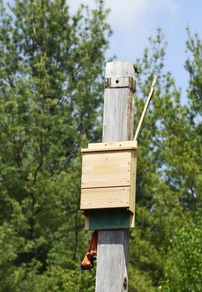
May 20, 2016
- Set one hawk box at the old logging yard off Tappan Trail
- Set bat box in the field at Tea Cup Lake (photo)
- Another hawk box is placed at a second site where the hole has been dug with hopes to set box soon
4/20/16
Work on the final phase of thinning the wildlife habitat has ended.
The holes needed to set the 30 ft. poles for the 2 Kestrel Hawk boxes and the 1 bat box are completed and poles will be set as soon as a truck crane is available.
1/1/16
The last phase of thinning (logging) the wildlife habitat will begin in mid January completing this phase of our Wildlife Habitat Management Plan.
1/20/16
Work has started on thinning the wildlife habitat, please use caution while using the trails.
2/27/16
The CSVW invited Cub Pack 369 from Moultonbough to join sanctuary coordinator Sarah Norton in the cleaning and preparing of several birdhouses located on the sanctuary property in anticipation of the upcoming migration. What initially was to be an event on snowshoes turned out to be more of a hike due to the lack of snow. This did not however dull these scouts spirits. It turned out to be a beautiful day.
Each scout and some of the parents took turns cleaning each birdhouse, adding new shavings and spraying the poles with ammonia to prevent any hungry or curious critters from trying to build their homes or make a meal of the new occupants. The scouts were excited to discover that in a few of the houses mice had built nests, and were amazed that they could climb the poles to get in the houses. The scouts also enjoyed reading several of the information stations located along the trails such as what a logging bow and a stone culvert were. All in all it was a great day. The scouts earned their Community Service Badges, had a great time on the trails with their friends and families and even learned a few things along the way. We look forward to sharing many more outdoor experiences with these young adventurers.
Photos on Calendar Page.
Work on the final phase of thinning the wildlife habitat has ended.
The holes needed to set the 30 ft. poles for the 2 Kestrel Hawk boxes and the 1 bat box are completed and poles will be set as soon as a truck crane is available.
1/1/16
The last phase of thinning (logging) the wildlife habitat will begin in mid January completing this phase of our Wildlife Habitat Management Plan.
1/20/16
Work has started on thinning the wildlife habitat, please use caution while using the trails.
2/27/16
The CSVW invited Cub Pack 369 from Moultonbough to join sanctuary coordinator Sarah Norton in the cleaning and preparing of several birdhouses located on the sanctuary property in anticipation of the upcoming migration. What initially was to be an event on snowshoes turned out to be more of a hike due to the lack of snow. This did not however dull these scouts spirits. It turned out to be a beautiful day.
Each scout and some of the parents took turns cleaning each birdhouse, adding new shavings and spraying the poles with ammonia to prevent any hungry or curious critters from trying to build their homes or make a meal of the new occupants. The scouts were excited to discover that in a few of the houses mice had built nests, and were amazed that they could climb the poles to get in the houses. The scouts also enjoyed reading several of the information stations located along the trails such as what a logging bow and a stone culvert were. All in all it was a great day. The scouts earned their Community Service Badges, had a great time on the trails with their friends and families and even learned a few things along the way. We look forward to sharing many more outdoor experiences with these young adventurers.
Photos on Calendar Page.

